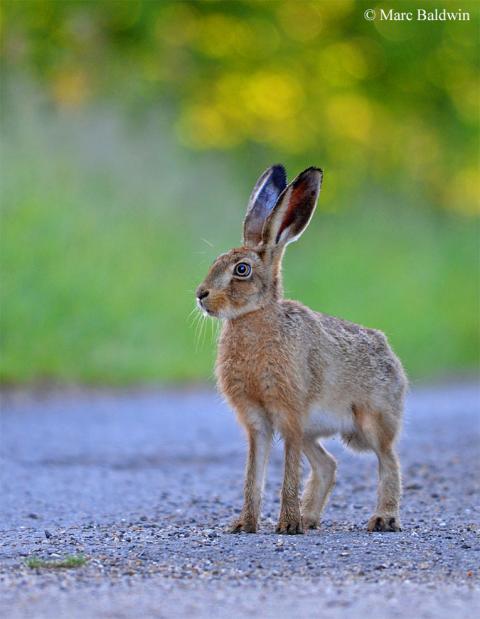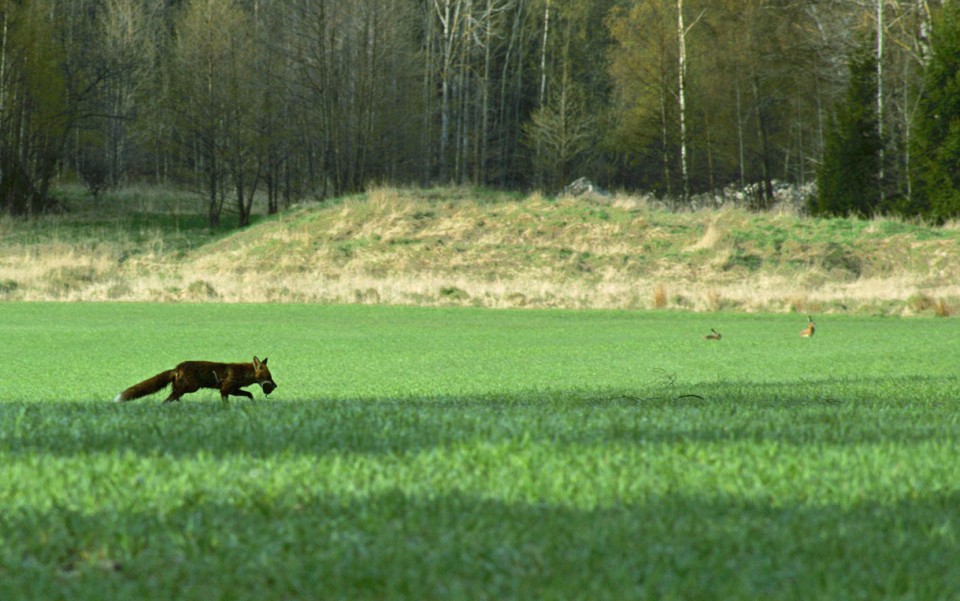Red Fox Interaction with Other Species - Small & Medium-sized Mammals
We have seen that foxes can have positive economic benefits to farmers by eating pest species such as rats, mice, voles and rabbits; but the question remains whether they can eat enough of these to control, or even reduce, their populations. Back in 1970, Australian biologist Ken Myers suggested that foxes could indeed have such a regulatory impact on prey (particularly rabbit) numbers, and several studies suggest that foxes can cause a decline in gamebird populations. It would be another decade or so before this theory would be empirically assessed.
Of rabbits and rodents
There is now some evidence that foxes can control the populations of certain prey species, although typically only after the numbers have first been reduced by something else (e.g. human persecution, disease, disaster, etc.). On the Yathong Nature Reserve in New South Wales, Australia during the early 1980s, for example, Alan Newsome and his colleagues found that predators -- i.e. foxes and feral cats -- maintained rabbit (Oryctolagus cuniculus) numbers at a relatively low level only after a severe drought caused an initial die-off.
Newsome and his co-workers observed that rabbit populations exploded, following the breaking of the drought, in areas where foxes and cats were continually shot; after just over a year, rabbit numbers in the predator controlled zone had risen by 12%. In parts of the reserve where foxes and cats weren't controlled, by contrast, the rabbit population had only risen by just under 3% during the same period, suggesting that the foxes and cats were suppressing the population. Similarly, around the same time, a study by former MAFF biologists Roger Trout and Andy Tittensor concluded that predator pressure on wild rabbits in England and Wales may limit increases in density, but only after numbers have been initially reduced by some other factor. In other words, if something acts to reduce rabbit numbers, foxes can keep the populations low; but they can't cause a reduction in rabbit numbers.

A somewhat more complex picture is seen in rodent and vole populations. In south-eastern Australia, foxes have had little impact on the plagues of house mice (Mus musculus) that periodically cause millions of dollars of damage to agricultural crops. Similarly, in Sweden a dramatic decline in fox abundance caused by a sarcoptic mange outbreak, failed to have any discernible impact on vole numbers. In Britain, Aberdeen University zoologist Declan O’Mahony and his colleagues considered that foxes should have a strong stabilising effect on vole populations, but that they do not appear to influence the three to four year "boom and bust" population cycles that we see in these rodents.
The reason foxes don’t appear to make much of a dent in the vole population is almost certainly because these rodents are prolific breeders. Indeed, in his 1980 book The Red Fox, Huw Lloyd notes that voles can survive mortality rates as high as 92% (i.e. only 8% of the population needs to survive to breed the following spring to sustain the population). In years of low productivity, foxes may take upto 40% of the vole population, but in "boom" years they cannot take more than about 3%. Lloyd concluded:
“Generally, what evidence there is indicates that the fox’s predatory role is of little significance in limiting the numbers of its main prey foods. It may, however, have an important effect on certain prey species in certain circumstances.”
More recently, during the mid-1990s, former Bristol University biologist Phil Baker and his colleagues studied the impact of foxes on various prey species on an organic farm in Wiltshire, arriving at much the same conclusion as Lloyd. Baker and his co-workers found no evidence that foxes were single-handedly regulating the populations of rabbits, bank voles (Myodes glareolus) or wood mice (Apodemus sylvaticus). The authors did, however, point out that, although foxes alone cannot control vole populations, such regulation is possible when the impact of other predators is considered. Indeed, one study found fox, kestrel, weasel and feral cat predation accounted for 85% of vole mortality.
Despite the foregoing, there are some reports implicating foxes in the control of some rodent populations and, in The Nature of Foxes, Rebecca Gambo tells how the removal of foxes in Wisconsin caused an explosion in the mouse population that led to their reintroduction. Such examples are presumably the exception, rather than the rule.
The situation is probably further complicated by observations that some rodents appear able to change their activity patterns to reduce the risk of being caught by a fox. In a paper to the Journal of Mammalogy during 1995, for example, Michael Fenn and David Macdonald reported that Norway rats (Rattus norvegicus) using a midden in Oxford’s Wytham Woods became strictly diurnal (i.e. active during the daytime) in the summer when the risk of fox predation was lower; when the threat was removed -- by enclosing the area with a fox-proof fence -- they reverted to the nocturnal activity normally observed in this species. So, the rats were altering their activity to make it less likely they would encounter a fox.
The fox and the hare
The situation between foxes and the brown hare (Lepus europaeus) is a complicated one. Many authors consider that foxes rarely take hares, while some studies suggest that they may be significant predators locally and that hares tend to prosper in areas with intensive fox control. In their 2010 Mammal Society booklet, The Brown Hare, Stephen Tapper and Derek Yalden succinctly summarise the issue:
“Although a fit adult hare has little to fear from a fox, it does not follow that fox predation is unimportant to hares. Foxes seem to have a big impact on hare populations because they kill leverets [baby hares]. A study in East Dorset showed that brown hares formed about 11% of the foxes’ diet, year-round, although this was an area where hares were not very numerous. From the numbers of foxes and brown hares, it was estimated that each fox killed about 50 leverets each year.”

Indeed, the influence that foxes have on brown hare populations is interesting. It has long been considered that foxes can detrimentally impact hare populations, with low hare numbers in areas with high fox densities. Britain’s hare population was probably at its peak during the early 1900s, when foxes were relentlessly persecuted by gamekeepers and has generally declined in the post-war years, although this may equally be a response to a change in farming practices as much as a reduction in the numbers of gamekeepers (and hence fox control). Research by the Game and Wildlife Conservation Trust (GWCT) has demonstrated that, in some regions at least, killing foxes can lead to an increase in hare populations and, in 1995, GWCT biologists Stephen Tapper and Jonathan Reynolds used a computer model to assess what would happen to a hare population if foxes were completely eliminated.
Tapper and Reynolds’ simulation suggested that, if foxes were removed, a given area of habitat could see a three- to six-fold increase in hares. Similarly, there is a noticeable correlation between areas with high levels of gamekeeper-led fox control (e.g. in much of eastern England) and increases in the hare population. Of particular importance seems to be the relationship between the peak of fox control, which is in the gamebird nesting season (April-July), and hare numbers; this period also corresponds to the peak period for the birth and growth of leverets. Curiously, however, some authors have observed a different response. Stephen Harris and Phil Baker point out in their contribution to Mammals of the British Isles, for example, that the increase in foxes in East Anglia hasn’t been paralleled by a decline in hares.
There is some evidence that season may have an important influence on the impact of foxes on hare populations, and a study in western Poland between 1996 and 2002 found that culling foxes had the greatest impact during the autumn and winter. Presumably, the combination of fox dispersal (autumn) and increased movement around the breeding season (winter), coupled with hares being more exposed (lack of vegetation) is significant in explaining this relationship. There is also some suggestion that some hare behaviour may also reduce the potential for fox predation.
In a rather obscure 1953 German paper D. Müller-Using described "three-toed walking" by hares in the presence of foxes. More recently, Anthony Holley studied brown hares living in the Somerset Levels in southern England between 1977 and 1987 and found evidence suggesting that they signalled to approaching foxes they had been spotted by standing on their hind legs and facing them – this they did in 31 of 32 encounters he saw. Holley noted that the hares didn’t do this when domestic dogs approached, suggesting it was a response to a known predator, although, in a 2007 paper to the New Zealand Journal of Zoology, John Flux described similar behaviour towards a cat that entered a field of hares he was watching. The idea, it seems, is that the hare stands up to signal that it has seen the predator and that there’s no point in the predator attempting a chase.

Finally, it appears that, although foxes may not be able to influence the cyclical nature of vole populations, they may transfer this cyclicity to the populations of other species, such as hare and grouse. In a 1994 paper to the journal Ecology, Swedish biologist Erik Lindström found that predation on these other species was higher in years when vole populations were low.
Intriguingly, when the Scandinavian fox population crashed as a result of the mange epidemic, Lindström observed that this "cofluctuation" (e.g. high vole population, high hare population) disappeared, suggesting that the foxes were responsible for it. In other words, the foxes preferentially took voles but when numbers dropped they turned their attentions to other species causing their populations to fluctuate in a similar manner. When voles were abundant, few hares were taken and numbers remained high; when vole populations crashed more hares were taken, causing a decline in their population. Lindström thus concluded that fox predation was a crucial factor in limiting the numbers of hare, grouse and deer kids (in the autumn) via the conveying of the vole boom-bust cycle to small game species.